Last Updated on: February 5, 2025
With its diverse landscapes and habitats, more than 500 bird species call Oregon their home. Most of them regularly breed in the state, staying year-round. Meanwhile, others are migratory.
From their physical appearance to feeding habits, there are many ways to identify and differentiate the birds in Oregon.
But…
For anyone who does not have sufficient birding knowledge, identifying the feathered creatures in the Beaver State can be overwhelming.
Take your birding knowledge to the next level! Read on as we help you identify birds present in the state.
The Most Common Oregon Birds
1. California Scrub-Jay
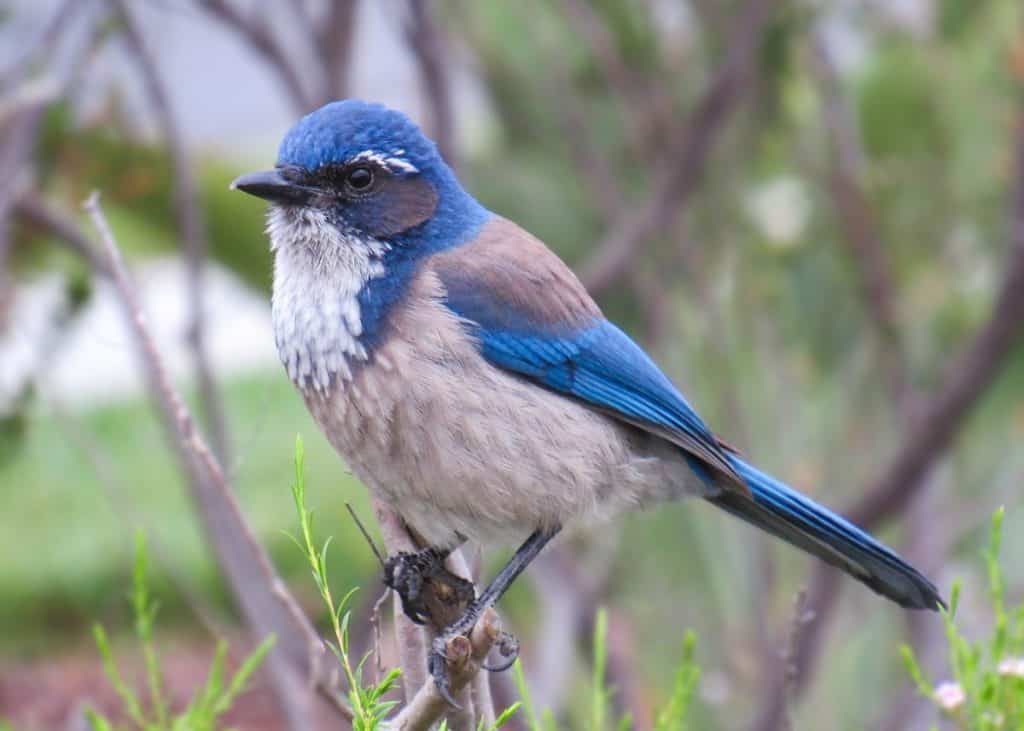
Starting off our list of the backyard birds in Oregon is the California scrub-jay. It is larger than most songbirds and has a beautiful light to dark blue color that makes it striking.
Aside from its stunning color, other physical identifiers of this bird include the gray upper body, blue necklace, and pale underside. More so, it has a floppy long tail with a hunched posture.
In Oregon, you will find California scrub-jays throughout the year. The population has the highest concentration in the western half, especially the Cascades.
Some of the most common places where you can see California scrub-jays are in suburban yards and oak woodlands. They are also common in city parks and private backyards.
The California scrub-jay is a vocal bird. You will often hear its high-pitched whistle and repetitive calls.
2. Black-Throated Green Warbler
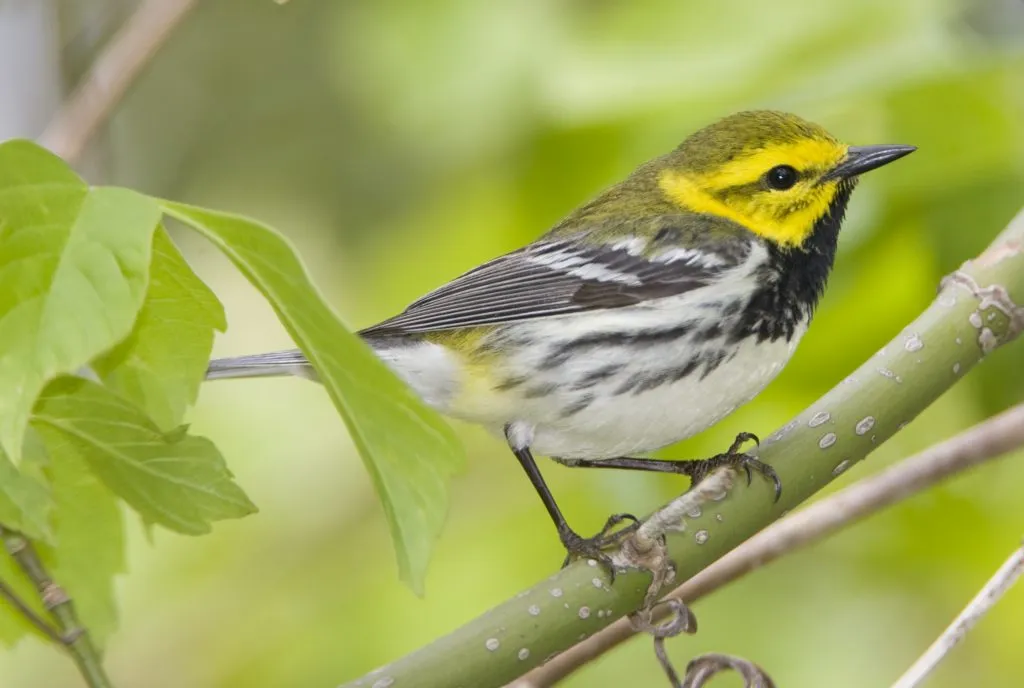
With its olive-green crown, yellow face, black throat, and white underbody, the black-throated warbler is an easily recognizable Oregon bird.
Males stand out because of their bright yellow faces. They also have two white wing bars. Meanwhile, even if the bodies of females have the same pattern as males, their colors are duller.
When you see a black-throated green warbler in the wild, you will notice how agile and active the bird is. It hides in the bases of leaves as it forages for insects to eat.
3. Dark-Eyed Junco

Considered winter birds in North America, dark-eyed juncos are present in eastern Oregon from October to March. If you head west, however, some of these birds can remain even when it is no longer cold.
The dark-eyed junco is a small bird, which is about the size of a house finch. It has a round body and head, a square-ended tail, and a short neck. Meanwhile, they have gray or brown wings. The specific hues can vary depending on location.
While they prefer eating seeds from the ground, it is also possible for dark-eyed juncos to visit bird feeders, especially those with mixed seeds.
4. House Sparrow
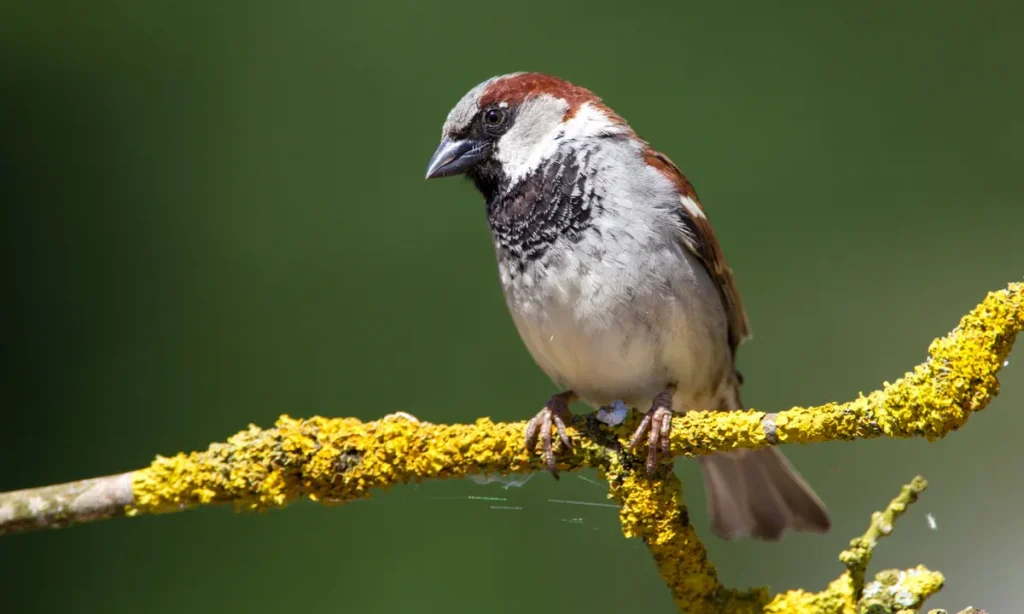
One of the most common songbirds in the country, house sparrows are in Oregon throughout the year. You will find them in places with houses and buildings, which is where the bird got its name.
Visually speaking, the house sparrow has a gray head, black bib, rufous neck, and white cheek. The back has brown, buff, and black stripes. Most of its body is pale brown.
No need to head far if you want to see house sparrows in Oregon. They live even in the city, including parks, streets, and gardens.
House sparrows are invasive species. They are often an unwelcome sight in backyards. They can compete with native birds and will push desirable birds away.
5. Song Sparrow
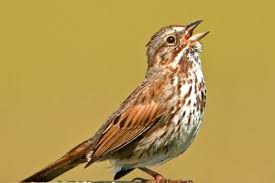
At first look, you will realize that the song sparrow is not as visually remarkable as the other birds on this list. It has mostly gray-brown streaks throughout the body, which can be difficult to spot in dense foliage.
As for its diet, a song sparrow will eat caterpillars, earthworms, midges, spiders, and beetles. They also consume sunflower seeds, wild berries, and blackberries, especially those that they will find in bird feeders.
The song sparrow is known for its distinct songs. Males use the latter to attract females in the spring and summer.
6. Violet-Green Swallow
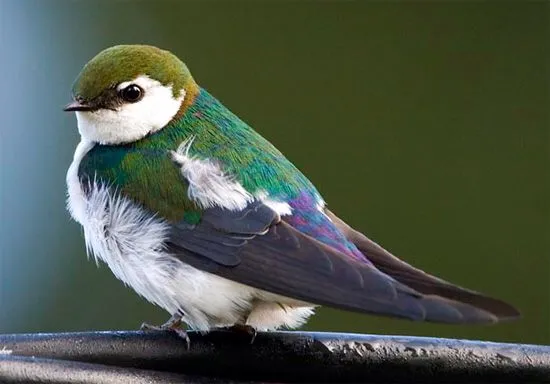
While it may not be as popular as the other birds on this list, the violet-green swallow is another bird you will often see in Oregon.
The bird is almost the same size as an American goldfinch, but the main difference is that it has longer wings. Other physical characteristics include a thin body, thick chest, and round head. Meanwhile, the upper back is lime green while the lower back is violet.
If you want to see violet-green swallows in Oregon, your best chance is to go birdwatching near ponds or lakes. Go there early in the morning and watch out above the sky as they like soaring in high altitudes.
7. House Finch
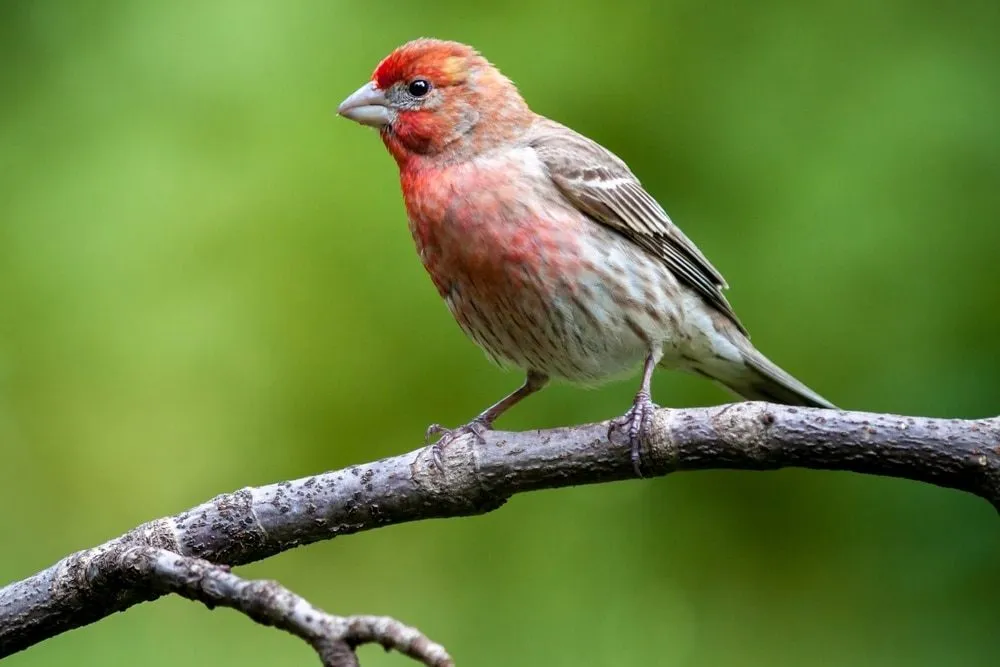
Present in the state throughout the year, house finches are among the most common backyard birds in Oregon. They can live in parks and farms, among other areas with human settlements.
These small birds have red faces and upper breasts. Meanwhile, their tails, bellies, and backs have brown streaks. When they are flying, the red rump is visible.
House finches will visit bird feeders. It likes black oil sunflower seeds and black seeds. The bird will also flock to thistle feeders.
The house finch is also known for feeding on the ground. It will walk on the surface as it looks for seeds, buds, and berries, which constitute the majority of its diet. Occasionally, it can also eat small insects, including aphids.
8. Blue Jay
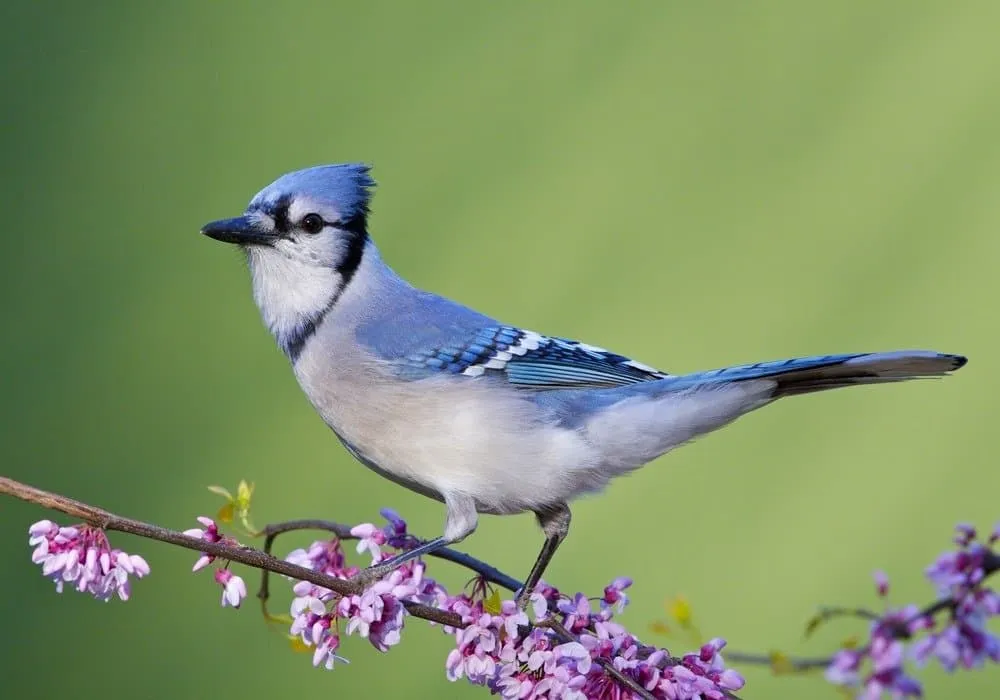
One of the most colorful birds on this list, the vibrant blue body is almost impossible to miss. Plus, they are quite loud, so it is almost impossible to not detect their presence.
While you can see blue jays in Oregon, they are rare sightings. Most of them are in the western and easter parts of the state from September to April.
Those who want to see blue jays in their natural habitats should head to deciduous groves and open mixed forests. Although, they can also be found in parks and orchards.
9. Black-Capped Chickadee
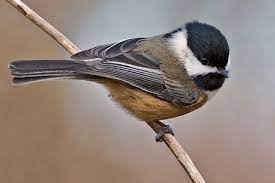
The name of the bird is from the black feathers on its cap, which extend under the eyes. The chest and cheeks are white. Meanwhile, they have gray wings with white edges.
Many people will describe the black-capped chickadee as cute when they see one. It has a tiny body and an oversized round head.
It is easy to attract black-capped chickadees to bird feeders. They can even visit hanging feeders. Provide them with their favorite food, including peanuts, suet, and sunflower seeds.
You will find black-capped chickadees in Oregon throughout the year. However, they are not in the southeastern portion of the state.
10. European Starling
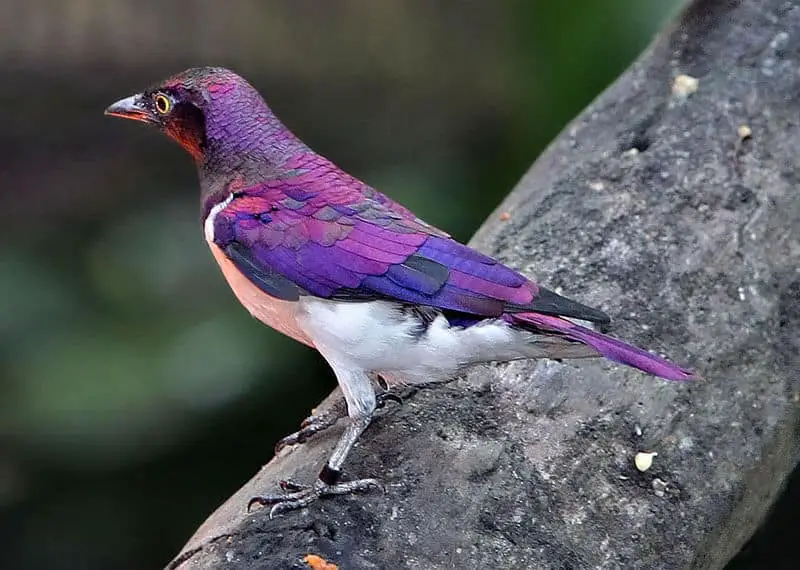
Introduced in North America in the 1800s, the European starling is one of the most widespread birds in Oregon. Nonetheless, many people hate them because they are invasive species. They are known for destroying nests.
They are black to grayish brown throughout the year. They also have iridescent blue, green, and purple tones. As they get older, the colors of these stocky birds become paler.
Because they are aggressive, they are not a welcome sight in many backyards. If you want to attract them, however, you should provide peanuts, cracked corn, suet, and black oil sunflower seeds.
11. Yellow-Rumped Warbler
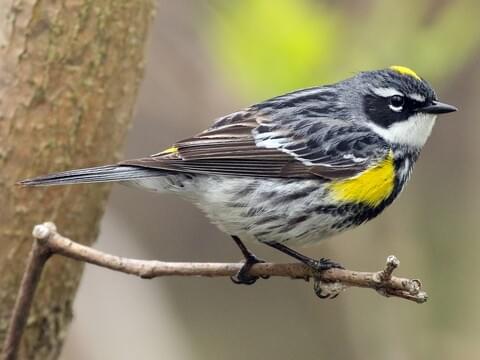
The colors of yellow-rumped warblers vary depending on their location. The most popular variety in Oregon is known as Audubon, which has bright yellow sides, rump, and throat. Females have similar colors except that they are duller.
As is common with other warblers, the yellow-rumped warbler is brighter in the spring and fades in the winter.
You will find yellow-rumped warblers in Oregon throughout the year, but they are most frequent from April to October. The latter coincides with their migration.
12. Golden-Crowned Sparrow

As it is named, one of the distinct characteristics of this Oregon bird is its bright yellow crown with black outer sides. It is pale gray underneath with brown streaks on the back. In the winter, their colors become duller.
The most common places where you will see golden-crowned sparrows are in weedy fields where it is searching for geranium, sumac, and dock. It also eats butterflies, beetles, termites, ants, grapes, olives, and apples.
It is possible to attract them in the backyard with bird feeders filled with seeds and fruits.
13. Northern Flicker
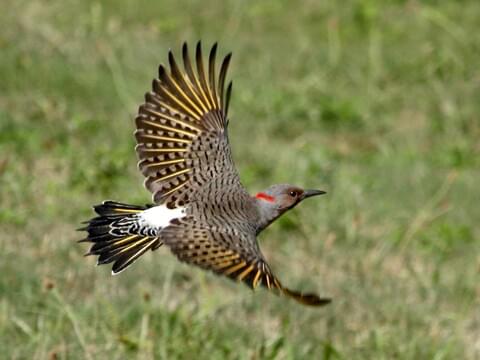
When talking about the most common backyard birds in Oregon, it is impossible to not mention the northern flicker. It is in the state throughout the year, but in the Cascades, these birds are present only in the breeding season.
They have brown bodies with white patches on the rump and black spots. Males also have a red nape. Their wings can have yellow or red flashes depending on their origin.
It is rare for northern flickers to visit bird feeders. Occasionally, they can come to suet feeders. If you want them in the backyard, put leaves on the ground, which is where they will dig for bugs.
14. Mourning Dove
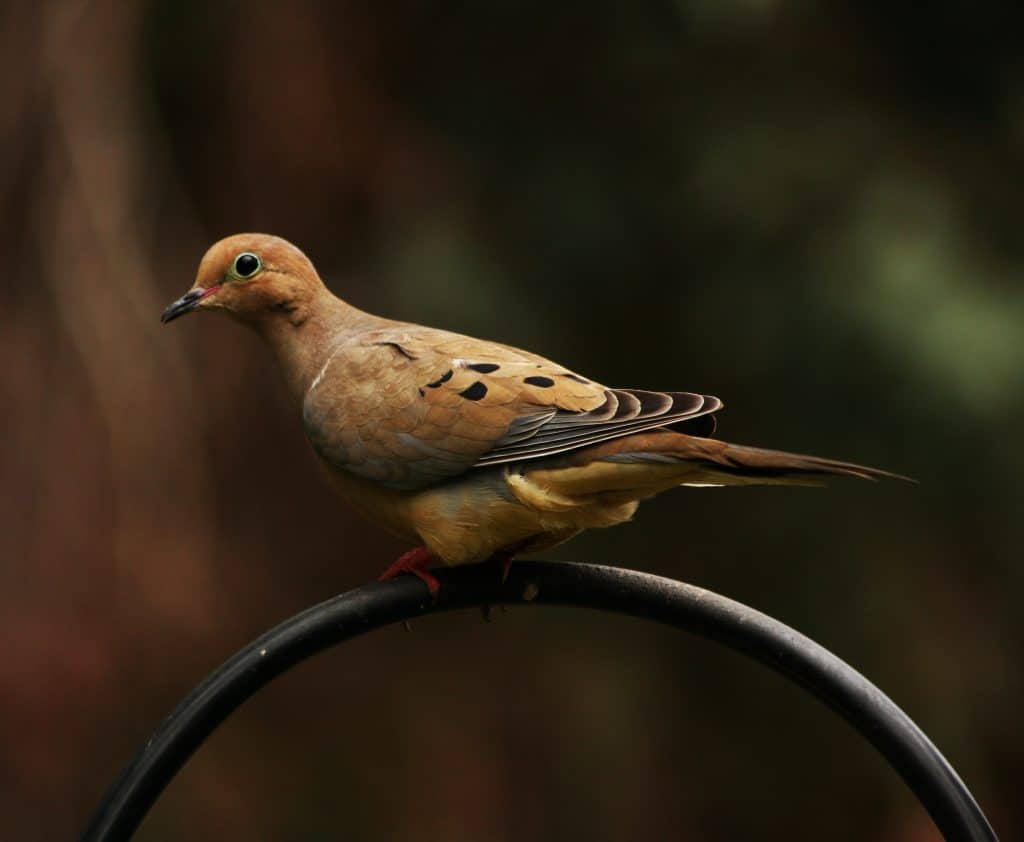
It is easy to recognize a mourning dove when you see one. They have plump bodies, long tails, and small heads. They have gray-brown upper parts with black wing spots.
A mourning dove feeds from dawn to dusk. It eats up to 20% of its body weight daily. They can also travel up to 20 miles when searching for food.
You can see mourning doves almost anywhere in Oregon but not in deep forests. They are most common on bare grounds and fields. They also perch on telephone wires.
15. Horned Lark
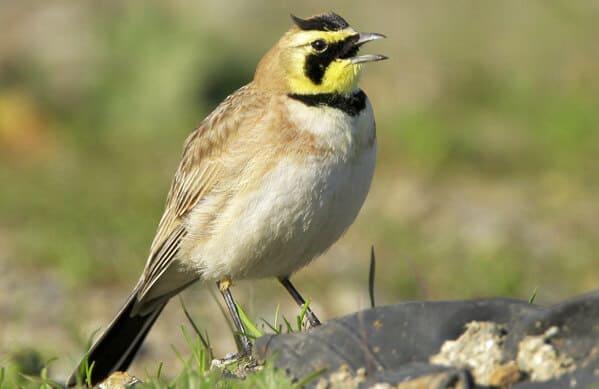
With an average length of six to eight inches, the horned lark is a small songbird. Males have highly visible horn-like feather tufts, which is where the bird got its name.
Other common physical characteristics of horned larks include round heads, thin bills, short necks, and long pointed wings.
Being social birds, you will often see horned larks in massive flocks, especially outside of their breeding season. You will see them in groups creeping on the ground searching for seeds and insects to eat.
Those who would like to see horned larks in Oregon should visit open countries with no or short vegetation. They are common in airports, fields, and prairies.
16. Cedar Waxwing
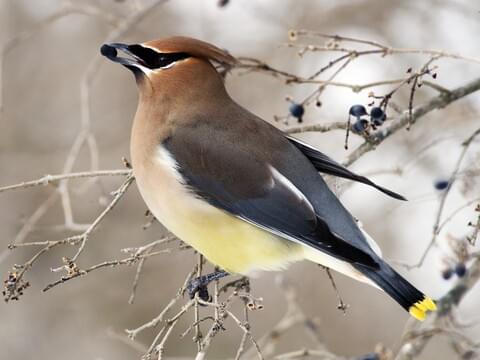
The name of this bird comes from the waxy red tips of their wing feathers. A cedar waxwing has a short neck, wide bill, gray tail, and pale yellow belly.
Is the cedar waxwing on your list of targets for a bird-watching trip in Oregon? Your best chances of seeing them would be in farms, woodlands, and orchards. It is also possible to find them in backyards, especially those with bird feeders.
The fruits of native trees and shrubs constitute most of the diet of cedar waxwings. They eat small fruits of hawthorn, winterberry, juniper, and dogwood. It also consumes fruits on platform feeders.
17. Western Tanager
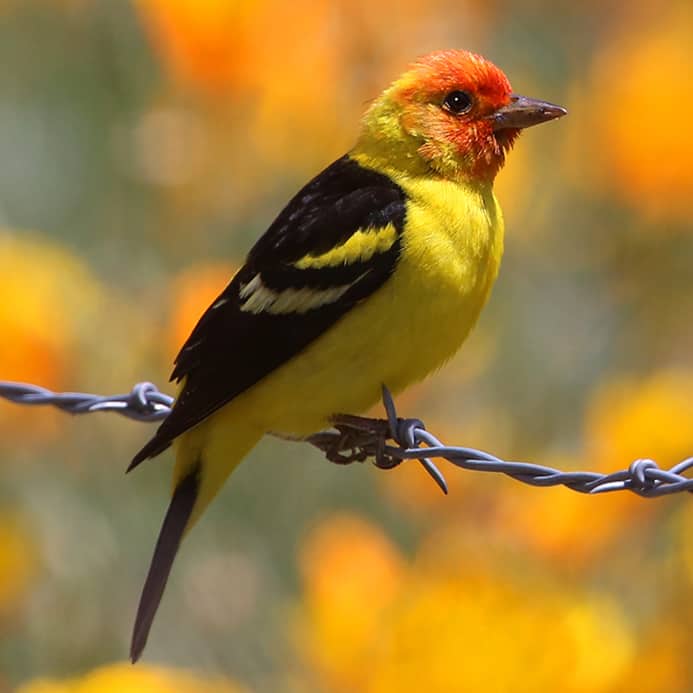
Present in Oregon during the breeding season, you will see the western tanager in the state from May to September.
The flaming orange-red head of the western tanager is one of the first things that you will notice in the bird. They have black wings and yellow bodies. Females, meanwhile, have red faces and yellow-green bodies.
Conifer forests are the preferred habitats of western tanagers. While they have bright colorings, they hide in canopies, making them difficult to spot.
In the summer, western tanagers eat insects, including grasshoppers and wasps. Meanwhile, in the fall and winter, they consume fruits.
18. Brown-Headed Cowbird
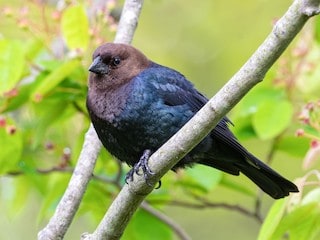
In the summer, it is common to see brown-headed cowbirds in Oregon. They are in the state from April to September.
Males have short tails, brown heads, and black bodies. Females, on the other hand, are smaller and mostly brown throughout the body with light streaks.
However, many people do not like seeing brown-headed cowbirds in the backyard. Many people think of them as a nuisance because they destroy the eggs of smaller songbirds that they find in their nests.
19. Indigo Bunting
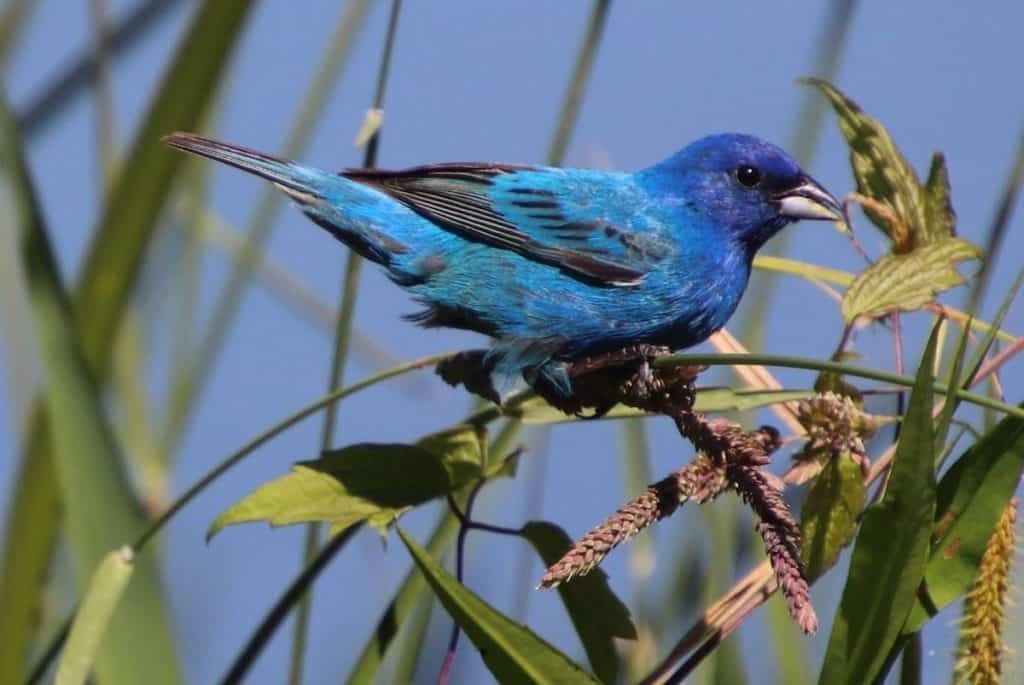
While it is not as common as the other backyard birds on this list, the indigo bunting deserves a mention. It is one of the most beautiful and colorful flying creatures in the state, although they are rare.
In the summer, the blue plumage of male indigo bunting is unmistakable. In the winter, they have brown and buff edges. Females, on the other hand, are always duller.
These birds eat seeds, especially in the winter. Meanwhile, in the breeding season, they eat mainly spiders and insects.
The indigo bunting is known for being a non-stop singer, especially for males. They have sweet and double-noted songs from telephone wires, treetops, and elevated perches.
20. Swainson’s Thrush
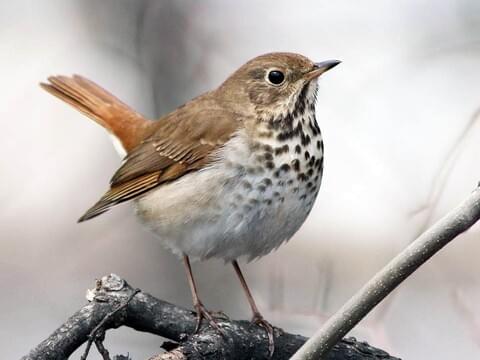
A shy bird, it is more common to hear than see the Swainson’s thrush. It has beautiful vocalizations with spiraling songs.
The Swainson’s thrush is a small songbird with a short bill, square-ended tail, long face, large head, and long wings. In terms of color, it has a brown upper body and pale undersides. The breast and throat are spotted brown. If you look closely, you will also find distinct eyerings.
They are in Oregon during their migration. Meanwhile, in the winter, they head to Central and South America.
If you are looking for Swainson’s thrushes, look for them in coniferous forests. They frequent locations with dense undergrowth. As for their diet, they eat insects and fruits.
21. Spotted Towhee
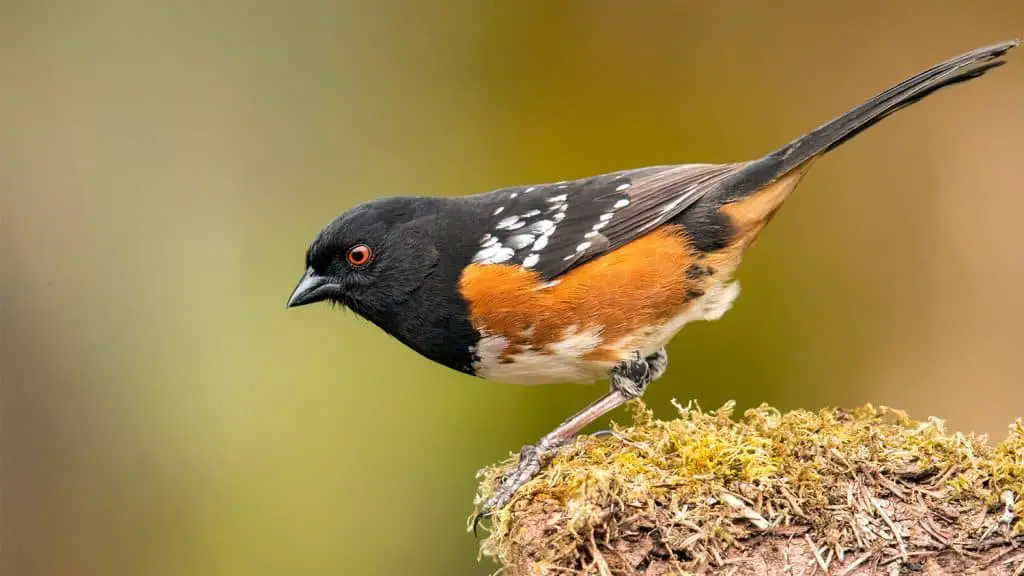
These backyard birds are a visual treat in Oregon. The throat and upper parts are jet-black. On the other hand, they have a black belly and black wings with bright white spots. Females have similar patterns, but they are grayish brown.
The spotted towhee has a reputation for being a master forager. It rummages through vegetation and leaf litter as it searches for berries, seeds, and insects. They hop and scratch, making them fun to watch.
They will not visit feeders often. However, they will look for seeds on the ground.
22. Anna’s Hummingbird
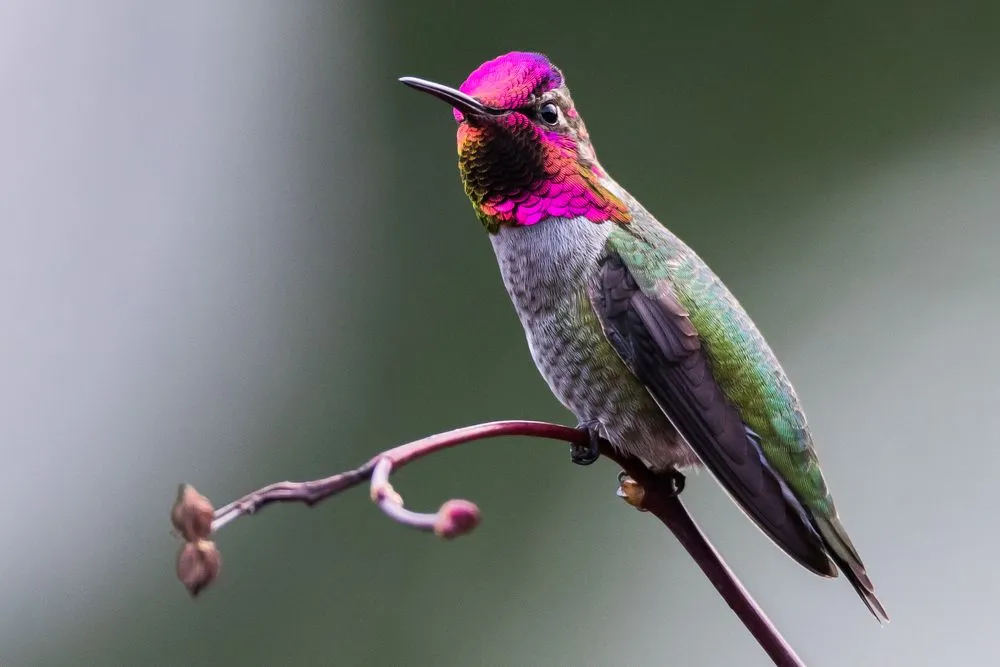
A tiny bird with a stocky body, Anna’s hummingbird has a broad tail and straight bill. It has gray-green upper parts. In males, the throat and head have red-pink feathers but may look gray or brown without direct sunlight.
Anna’s hummingbirds shake their tail feathers to generate noise. This is a result of fluttering while flying at a high speed.
Aside from this sound, they are also acrobatic when luring a mate. During courtship, males climb at an elevation of up to 130 feet and dove to the ground.
If you want to attract them in your backyard, install hummingbird feeders with sugar water. Alternatively, you can also add colorful plants and nectar feeders.
23. Ruby-Crowned Kinglet
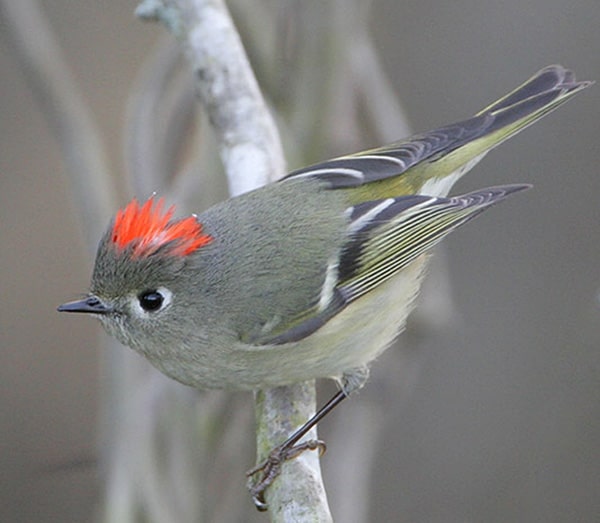
You will see ruby-crowned winglets in western Oregon in the winter. They are most common in tall and dense conifer forests, especially those with tamarack, fir, and spruce.
These winter birds are known for being acrobatic and restless, making them a joy to watch. They will move quickly and flick their wings as they go. Since they are agile, spotting them can be a challenge.
If you want ruby-crowned kinglets to come to the backyard, install hulled sunflower seeds, mealworms, and peanut hearts.
24. Red-Winged Blackbird
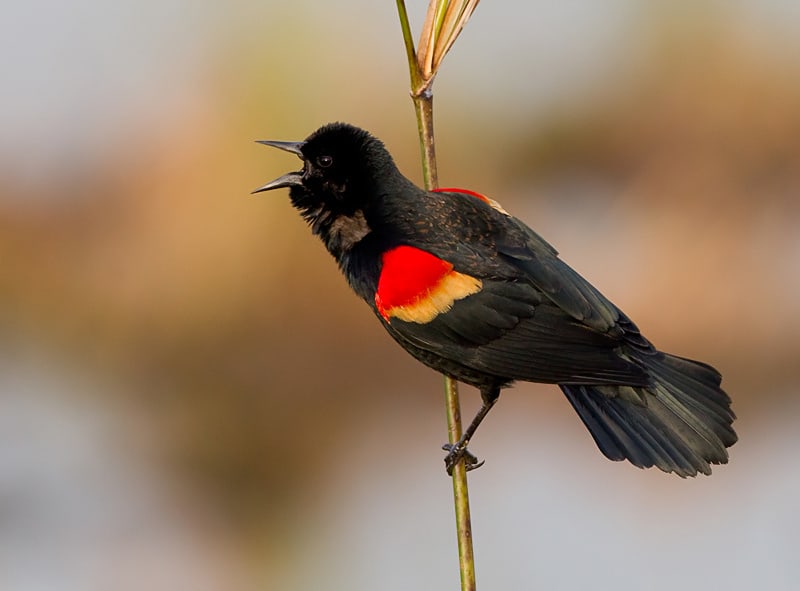
With the way they are named, you will already have a clue of what red-winged blackbirds look like. Males are glossy black with red wings with yellow edges. Females, on the other hand, are brown with streaks throughout their bodies.
During the breeding season, it is most common to see red-winged blackbirds in wet locations, such as salt and freshwater marshes. They can also be present in pastures, grasslands, and agricultural fields.
Males can be aggressive. They will defend their territories fiercely from anyone they perceive as a threat, whether it is birds or humans.
25. Northern Waterthrush
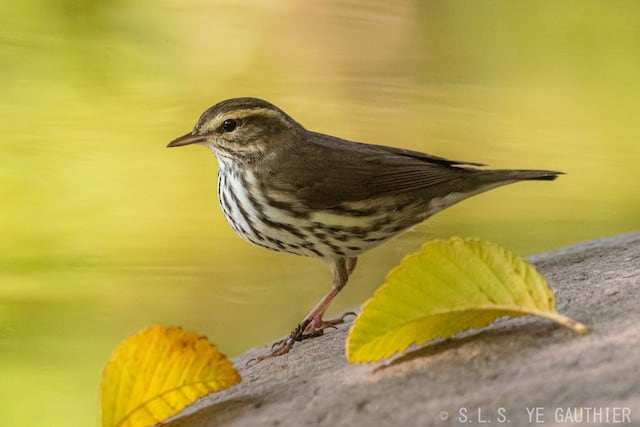
With dark brown upperparts, pale yellow underpart, and a prominent pale eyebrow, the northern waterthrush is another great addition to the birds on this list.
It is known for foraging in or near the ground as it hunts for food. It can also be seen in shallow water. Their long legs allow them to wade.
The most common habitat of the northern waterthrush is in locations with stagnant water.
26. Western Meadowlark
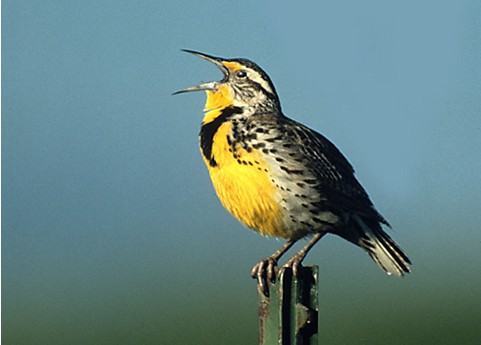
The western meadowlark is the official state bird of Oregon, so it is just right that we include it on the list.
To identify a western meadowlark, one of the first things to look for is the black V pattern that looks like a necklace on its yellow breast. It also has yellow underparts with intricate patterns.
You can see western meadowlarks in Oregon throughout the year. Nonetheless, their sightings are most prominent from March to June.
It is possible to lure western meadowlarks in bird feeders with hulled black oil sunflower seeds and cracked corn. They will also consume insects, including grasshoppers, caterpillars, snails, ants, and true bugs.
27. American Crow

One of the most common Oregon backyard birds, American crows are in the state throughout the year. Whether it is summer or winter, you can find them in Beaver State.
It is almost impossible to miss an American crow when you see one. It is all-black, but the feathers appear molted and dull once the bird gets older.
Aside from their color, another easy way to detect the presence of American crows is through their cawing sound. They have a hoarse call, which is easily noticeable because it is common for them to gather in large groups.
Many homeowners do not like having American crows in the backyard. They can disturb pet food and trash.
28. Bald Eagle
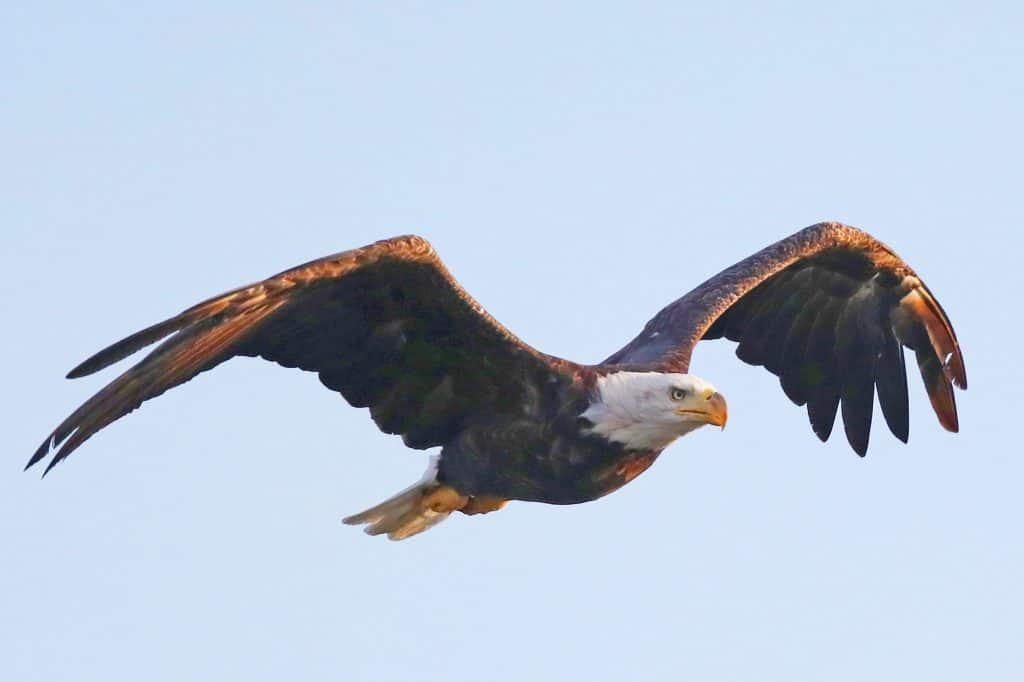
The bald eagle is popular for being the emblem bird of the United States. Luckily, you will find these mighty raptors in Oregon.
With its large head, long bill, and heavy body, you can easily identify a bald eagle when you see one. They have dark brown bodies with white tails and heads. The bills and legs, on the other hand, are bright yellow.
Bald eagles are known for being opportunistic. They can be scavengers or predators. When it is hunting, it stays high on a perch and quickly swoops once it spots prey.
The diet is mostly fish, including catfish, carp, salmon, and herring. At times, it can also eat small mammals and birds.
29. Red-Tailed Hawk

While you will find several birds of prey in Oregon, one of the most popular is the red-tailed hawk.
The red-tailed hawk has broad and rounded wings and a short and wide tail. The wings can extend up to 53 inches wide when it is flying, making the bird a visual treat.
Most of these hawks are rich brown on the upper body and paler below. The belly is streaked while there is a dark bar between the wrist and shoulder.
It is usual to see these hawks circling as a group above open fields. They can also spend their time on fenceposts and telephone poles.
30. White-crowned Sparrow

It is quick to identify this sparrow once you see one. The first thing to look at is its head with black and white stripes. Most parts of their bodies, on the other hand, are brown-gray.
Seeds and vegetable matter make the most of the diet of white-crowned sparrows. In the winter, they prefer eating seeds, especially from grasses and weeds. Come summer, their diet shifts to insects, which is only what most of the young ones eat.
In most parts of the state, the white-crowned sparrow is present only in the winter. However, if you are along the coast, you can find them throughout the year.
Roaming Tip: Why not take a visit to the sunniest state in the US and inspect some backyards for perching birds? Fly over here — Florida Backyard Birds.
Watch This!
Frequently Asked Questions
What is the Oregon state bird?
The state bird of Oregon is the western meadowlark. It has a flute-like song, which makes it easy to recognize the bird before it is seen. Appearance-wise, the bird has a yellow breast and black collar. Meanwhile, the bill is long and pointed, which the bird uses to poke into the soil in search of insects and seeds to eat.
Where can I see birds in Oregon?
Among the 50 states, Oregon has the sixth-highest bird species. With this, the state is gifted with many exceptional spots for birdwatching, including Malheur National Wildlife Refuge, Fern Ridge Wildlife Management Area, Crater Lake National Park, Cottonwood Canyon, Summer Lake Wildlife Area, Lake Albert, and Ankeny Wildlife Refuge.
Conclusion
Oregon is well-loved by nature lovers because of its diverse bird species. From small songbirds to large raptors, the state is home to a wide array of flying creatures, including year-round residents and migratory birds. Many of them can come to your backyard with the right bird feeders.
Are there other Oregon birds that we missed on this list? Leave a comment below and share what we have missed.

